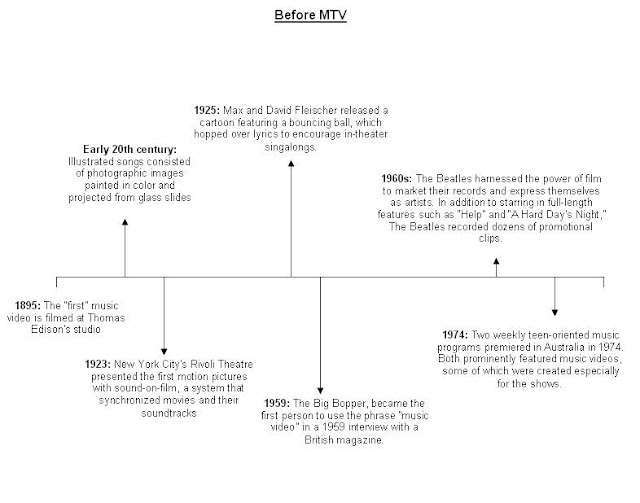This music genre mindmap is to help me look at some genres that interest me which will enable me to decide what I want to look at when doing my format research and video shoot.
Thursday, 27 September 2012
Tuesday, 18 September 2012
Little bits of analysis - Music videos
The Buggles – Video killed the radio star (1979)
Genre – Pop
Audience – All
Lyrics – Relating to relationships
Camera – Zooming on to instruments and televisions
Mise en scene – Futuristic clothing, white setting with three pianos,
Editing – Quite a lot of shots
Dire Straits – Money for nothing (1985)
Genre – Rock: Often shows band performing
Audience – Males
Lyrics – Lyrics relating to visuals
Camera – Mix between long shots and close ups
Mise en scene – Neon lighting and clothing, 80’s standard clothing when performing
Effects – Cartoon effects
Editing – A lot of transitions, framing shots
Michael Jackson – Thriller (1982)
Genre – Pop
Audience – Getting a wider audience instead of children and teens as his fan base due to Michael Jackson starting off in Jackson
Lyrics – The lyrics relates to the zombie atmosphere
Mise en scene – (Film bit: 80s standard clothes, dark at night, in woods) Music – Smoke/fog, dark, red leather clothes, grave yard, zombies – effects with their make up and blood.
Effects – Smoke effects
Editing – Film style, 4 minutes before music even starts
Tuesday, 11 September 2012
History of music videos
A music video is a short film mixing imagery with the song which is used to promote the song for the artist and now is produced as a marketing technique. Original music videos date back much further however they were mainly used in the 1980s when MTV started to base their system on the medium. Before the 1980’s music videos were usually referred to as an ‘illustrated song’ or a ‘film insert’. Although music videos date back as far as the 19th century, 30 years ago, it was considered the music video ‘heyday’ when MTV famously aired ‘The Buggles’ “Video Killed the Radio Star” on August 1st, 1981. Below is that music video which has gathered 3,630,997 views on vevo - it was uploaded late 2010
Music videos use a variety of styles of film techniques such as animation, live action filming and performance based approaches like abstract film. Some music videos even take two techniques and blend them, for example, animation and live action blend. Many music videos do not interpret images from the song's lyrics, making it more fictional than expected and other music videos may not have a set concept and being simply a filmed vision of the song's live performance. The first example of an ‘illustrated song’ was in 1894, it was still images set to the live performance ‘little lost child’. Following that many musical short films were produced featuring many bands, vocalists and dancers. In the 1930s screen songs were introduced – this included cartoon films which encouraged the audience to sing-a-long. A step up from this was when the first promotional clip was introduced; they were short films of the band on a movie-set. This was one of the first times; music videos were used as a marketing technique. In the mid 60s The Beatles set the stage for the modern music video with the motion picture “A Hard Days Night.” This was only the start; they followed to making 10 films which promoted their album releases. By the 80s MTV was introduced and the 24 hour broadcast begins to play a role in music marketing. Michael Jackson in 1983 made the most influential video of all time. “Thriller” was a narrative music video and had a storyline to the song he was marketing. After that, music videos became a big medium used to promote singles and albums and it grew bigger due to things such as youtube and downloadable music videos on iTunes.
Subscribe to:
Comments (Atom)


